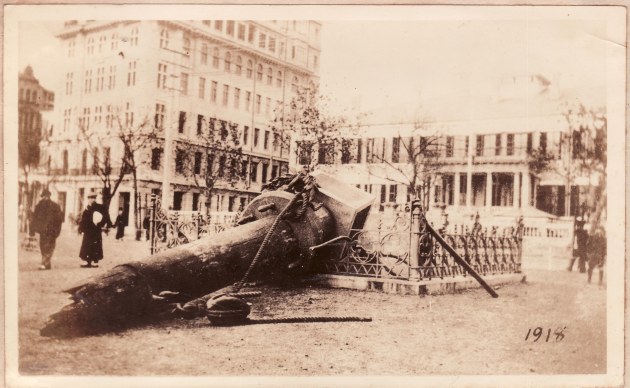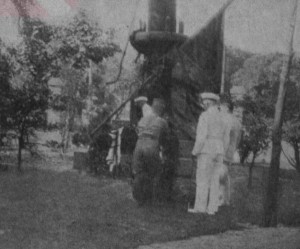 The Kaiser approved. Well, at least, his favourite sculptor Rheinhold Begas did, the man whose florid creations littered the sites of Wilhelmine power in Germany, and had oversight of the creation of the first German memorial erected in Shanghai. The Iltis Monument — the Iltis Denkmal, 伊尔底司碑 — commemorated the 77 dead German naval personnel, whose ship, the gunboat SMS Iltis, had foundered off the Shandong coast in July 1896. As the vessel sank the men were reported to have gathered around the mast and sung a hymn: ‘Now thank we all our God’. Three days earlier the ship’s officers had entertained Shanghai society at a reception on board, and so it seemed only proper that the International Settlement should host a memorial. The German seizure of Jiaozhou Bay (‘Kiaochow’), and the development of what became the city of Qingdao did not take place until 1897, and Shanghai hosted the largest community of the ‘China Germans’, who were inscribed as such — Die Deutschen Chinas — on the memorial itself.
The Kaiser approved. Well, at least, his favourite sculptor Rheinhold Begas did, the man whose florid creations littered the sites of Wilhelmine power in Germany, and had oversight of the creation of the first German memorial erected in Shanghai. The Iltis Monument — the Iltis Denkmal, 伊尔底司碑 — commemorated the 77 dead German naval personnel, whose ship, the gunboat SMS Iltis, had foundered off the Shandong coast in July 1896. As the vessel sank the men were reported to have gathered around the mast and sung a hymn: ‘Now thank we all our God’. Three days earlier the ship’s officers had entertained Shanghai society at a reception on board, and so it seemed only proper that the International Settlement should host a memorial. The German seizure of Jiaozhou Bay (‘Kiaochow’), and the development of what became the city of Qingdao did not take place until 1897, and Shanghai hosted the largest community of the ‘China Germans’, who were inscribed as such — Die Deutschen Chinas — on the memorial itself.
 Three and a tons of bronze were cast into the shape of a broken mast, around which was wrapped a flag on a staff. A broken mast was a common funerary device, given added piquancy in this case by the facts of the Shandong disaster. The design was sketched by a German naval officer, and then the monument was designed by August Kraus. It was cast in Germany and shipped out to China where it was placed on the Bund, not far from the entrance to the Public Garden and close to the German Club Concordia.
Three and a tons of bronze were cast into the shape of a broken mast, around which was wrapped a flag on a staff. A broken mast was a common funerary device, given added piquancy in this case by the facts of the Shandong disaster. The design was sketched by a German naval officer, and then the monument was designed by August Kraus. It was cast in Germany and shipped out to China where it was placed on the Bund, not far from the entrance to the Public Garden and close to the German Club Concordia.
It was unveiled by Prinz Albert Wilhelm Heinrich von Preußen (Crown Prince Henry of Prussia) on 21 November 1898. A German naval band played the hymn the crew had sung. Even more than the Allied War Memorial unveiled a quarter of a century later, the Iltis Monument came to serve a ceremonial function. The visual life of the structure online attests to this — for there seem to be many more postcards and other images of this monument than any of the others that were erected, and so more collateral records of it have survived. It came to be a common ritual for visiting German dignitaries or military personnel to pay a formal visit to the site and to lay a wreath, and this is recorded in photographs and postcards.
If the monument acquired a life as a nationalistic symbol, it was also much lauded as a symbol of Anglo-German friendship. The memorial was situated on a piece of the Bund foreshore that the British firm Jardine Matheson & Co. had residual rights to, but the company had pointedly acceded with alacrity to the request to allow the monument to be sited there. The interests of treaty port Germans and Britons were increasingly closely intertwined at this point. They formed companies together, hosted each other at their clubs, collaborated in running Shanghai’s International Settlement and Race Club, saluted each others’ monarchs, and cemented their commercial relations through marriage. Respecting and honouring the dead of the Iltis disaster was a part of this.
Breaking apart these ties when the lengthening war demanded it in 1914 proved difficult. But the Lusitania sinking in May 1915 and the ‘Roll of Honour’ published in the British Shanghai press started to have a tangible impact. With the allied victory in November 1918 debate immediately commenced about the Iltis monument. Why, demanded some, was a nationalist monument ever allowed to be erected on the internationalised Bund. But why should triumph change our past view, others countered, of the heroism of the men it honoured: ‘Is victory to turn us into Huns?’ asked one British woman? But the debate proved irrelevant, for a large contingent of French sailors, aided by others, pulled the memorial over on the evening of 1-2 December 1918 and made off with the flagstaff. Nobody saw a thing, funnily enough.
But the monument survived (and even the flagstaff was anonymously returned). The structure was placed in storage, and in 1929 it was restored to the German community and re-erected in the grounds of the German school in the west of the settlement. There it resumed a ceremonial role, as a site for annual Volkstrauertag — memorial day — ceremonies on 16 March. These were steadily Nazified after 1934 as ‘Heroes’ Day’ (Heldengedenktag). The Iltis made the longest journey of the mobile stone and bronze memorials that were erected on the Bund, and proved the most potent of symbols, to its friends and to its enemies. It was tied up both with the rising imperialism and nationalism of the Wilhelmine state, the Nazification of the Shanghai Germans after 1933, and of course the unforgiving belligerence of the victorious allies. But for some the attack on the monument broke a taboo: foreign power in China was rooted in solidarity, even when the imperialist states jockeyed for advantage and position with each other. The destruction of the memorial set a very bad example, some argued — German and Briton alike in 1914 — for who alone, ultimately, stood to gain from the internecine strife of the Europeans, if not the Chinese.




